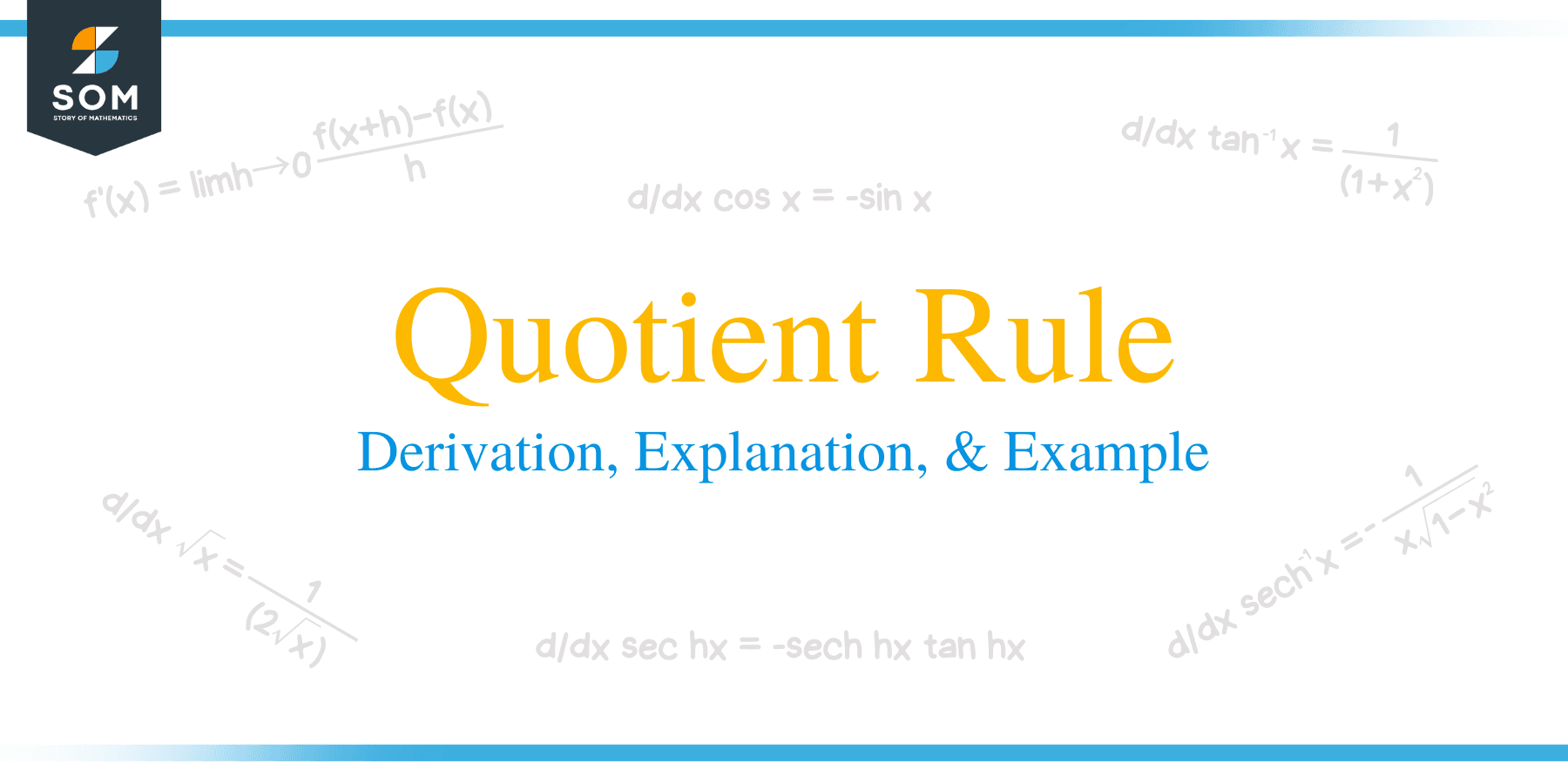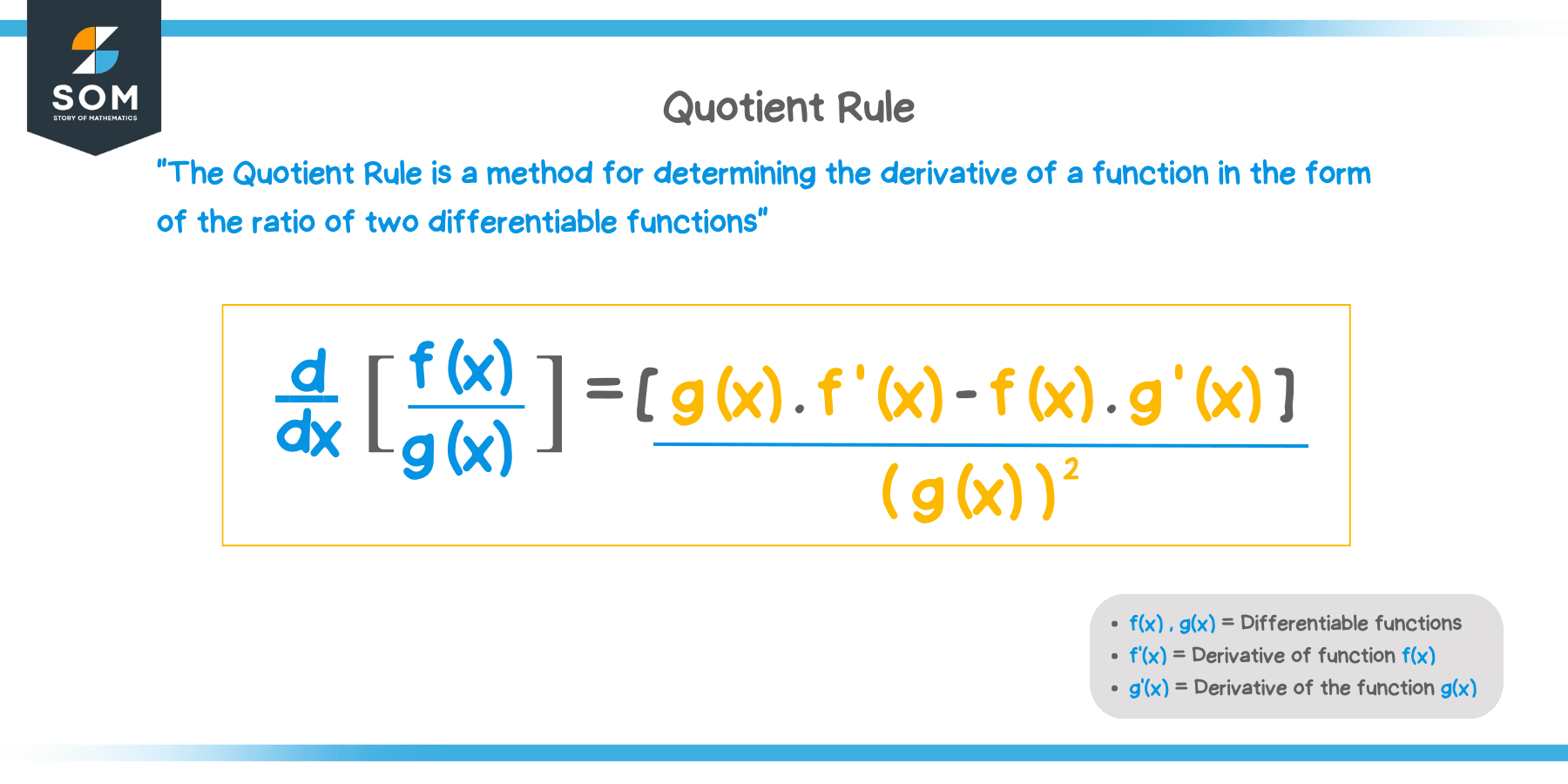- Home
- >
- Quotient rule – Derivation, Explanation, and Example
Quotient rule – Derivation, Explanation, and Example
 The quotient rule is an important derivative rule that you’ll learn in your differential calculus classes. This technique is most helpful when finding the derivative of rational expressions or functions that can be expressed as ratios of two simpler expressions.
The quotient rule is an important derivative rule that you’ll learn in your differential calculus classes. This technique is most helpful when finding the derivative of rational expressions or functions that can be expressed as ratios of two simpler expressions.
The quotient rule helps us differentiate functions that contain numerator and denominator in their expressions. These will make use of the numerator and denominator’s expressions and their respective derivatives.
Mastering this particular rule or technique will require continuous practice. In this article, you’ll learn how to:
Describe the quotient rule using your own words.
Learn how to apply this to different functions.
Master how we can use other derivative rules along with the quotient rules.
Make sure to keep your list of derivative rules to help you catch up with the other derivative rules we might need to apply to differentiate our examples fully. For now, why don’t we go ahead and understand the quotient rule’s process by heart?
What is the quotient rule?
The quotient rule states that the derivative of the function, $h(x) = \dfrac{f(x)}{g(x)}$, is equal to the product of the denominator and the derivative of the numerator minus the product of the numerator and the derivative of the denominator. The resulting expression will then be divided by the square of the denominator.
There are instances when the function we’re working with is a rational expression. When this happens, it helps if you know the quotient rule for derivatives. This means that the quotient rule is most helpful when we’re working with functions that are the ratios of two expressions.
When we’re given a rational expression function (meaning it contains expressions in its numerator and denominator), we can use the quotient rule to find its derivative.
Now that we know how the quotient rule works, let’s understand the formula for the quotient rule and learn how to derive it.
What is the formula for the quotient rule derivative?
When we’re given a function, $h(x) = \dfrac{f(x)}{g(x)}$, we can find its derivative using quotient rule’s formula as shown below.
\begin{aligned} \dfrac{d}{dx} \left[\dfrac{f(x)}{g(x)} \right] &= \dfrac{g(x) \dfrac{d}{dx} f(x) – f(x) \dfrac{d}{dx} g(x)}{[g(x)]^2}\\&= \dfrac{g(x) f'(x) – f(x) g'(x)}{[g(x)]^2}\end{aligned}
This means that when we’re given a function that can be rewritten as $h(x) = \dfrac{f(x)}{g(x)}$, we can find its derivative by following the steps described below:
Find the derivative of the $f(x)$ (or the numerator) and multiply it with the $g(x)$ (or the numerator).
Find the derivative of the $g(x)$ (or the denominator) and multiply it with the $f(x)$ (or the numerator).
Subtract these two, then divide the result by the square of the denominator, $[g(x)]^2$.

We can use this formula for different types of rational expressions, and any function is rewritten as ratios of two simpler expressions. Make sure that you know this process by heart after this discussion. Don’t worry; we’ve prepared mnemonic tips, derivation of formulas, and examples to help you.
Proof of the quotient rule for derivatives
If you’re the type who easily remembers a formula by learning how it is derived, we’ll show you a proof of the quotient rule similar to the product rule formula’s derivation.
We begin with the formal definition of derivatives and write $\dfrac{d}{dx} \left[\dfrac{f(x)}{g(x)}\right]$ in that form.
\begin{aligned} h'(x) &= \dfrac{d}{dx} \left[\dfrac{f(x)}{g(x)}\right]\\&= \lim_{h \rightarrow 0} \dfrac{\dfrac{f(x +h)}{g(x+h)} – \dfrac{f(x)}{g(x)}}{h}\\&= \lim_{h \rightarrow 0}\dfrac{1}{h}\left[\dfrac{f(x +h)}{g(x+h)} – \dfrac{f(x)}{g(x)}\right] \end{aligned}
We can manipulate this expression and come up with the expressions shown below:
\begin{aligned} h'(x) &= \lim_{h \rightarrow 0}\dfrac{1}{h}\left[\dfrac{f(x +h)g(x)}{g(x)g(x+h)} – \dfrac{f(x)g(x +h)}{g(x)g(x+h)}\right]\\&= \lim_{h \rightarrow 0}\dfrac{1}{h}\left[\dfrac{f(x +h)g(x)-f(x)g(x +h)}{g(x)g(x+h)}\right]\\&= \lim_{h \rightarrow 0}\dfrac{1}{h}\left[\dfrac{f(x +h)g(x){\color{green}-f(x)g(x)}+f(x)g(x +h){\color{green}+f(x)g(x)}}{g(x)g(x+h)}\right]\\&= \lim_{h \rightarrow 0}\dfrac{1}{h}\left[\dfrac{g(x)[f(x+h) -f(x)]-f(x)[g(x+h) -g(x)]}{g(x)g(x+h)}\right] \end{aligned}
Let’s rewrite this expression to have the formal expressions for $f’(x)$ and $g’(x)$.
\begin{aligned} h'(x) &= \lim_{h \rightarrow 0}\dfrac{1}{g(x)g(x+h)}\left[\dfrac{g(x)[f(x+h) -f(x)]-f(x)[g(x+h) -g(x)]}{h}\right]\\&= \lim_{h \rightarrow 0}\dfrac{1}{g(x)g(x+h)}\left[g(x)\lim_{h \rightarrow 0}\dfrac{[f(x+h) -f(x)]}{h}- f(x)\lim_{h \rightarrow 0} \dfrac{[g(x+h) -g(x)]}{h}\right]\\&= \dfrac{1}{g(x)g(x)}\left[g(x)f'(x) – f(x)g'(x) \right ]\\&= \dfrac{g(x)f'(x)-f(x)g'(x)}{[g(x)]^2} \end{aligned}
Use this section as a guide when deriving the proof of quotient rule. This also shows you how helpful this rule is since we no longer have to do this process repeatedly each time we find the derivative of $h(x) = \dfrac{f(x)}{g(x)}$.
When to use the quotient rule and how to use mnemonics for the formula?
The quotient is most helpful when we’re given expressions that are rational expressions or can be rewritten as rational expressions. Here are some examples of functions that will benefit from the quotient rule:
Finding the derivative of $h(x) = \dfrac{\cos x}{x^3}$.
Differentiating the expression of $y = \dfrac{\ln x}{x – 2} – 2$.
It helps that the rational expression is simplified before differentiating the expression using the quotient rule’s formula. Speaking of the quotient rule, another way to write this rule and maybe help you remember the formula is $\left(\dfrac{f}{g}\right) = \dfrac{gf’ – fg’}{g^2}$. The formula may seem intimidating at first, but here are some mnemonics to help you familiarize the quotient rule:
Try saying the quotient rule out loud and assign helpful key terms to guide you like “$g$ $f$ prime minus $f$ $g$ prime all over $g$ squared.
Here’s another: “low derivative of high minus high derivative of low all over low squared.” For this case, “low” means the lower expression (i.e., the denominator), and “high” means the higher expression (or the numerator).
There’s a shortened phrase for this too: “low $d$ of high minus high $d$ of low all over low low.”
These are just some of the many mnemonic guides to help you. In fact, you can also come up with an original one for yourself!
Of course, the best way to mastering this rule is by repeatedly finding the derivatives of different functions.
Example 1
Find the derivative of $h(x) = \dfrac{2x- 1}{x + 3}$ using the quotient rule.
Solution
We can see that $h(x)$ is indeed a rational expression, so the best way to differentiate $h(x)$ is by using the quotient rule. First, let’s express $h(x)$ as ratios of two expressions, $\dfrac{f(x)}{g(x)}$ then take their respective derivatives.
Function | Derivative |
\begin{aligned}f(x) &= 2x-1 \end{aligned} | \begin{aligned}f'(x) &= \dfrac{d}{x} (2x-1)\\&= 2 \cdot \dfrac{d}{dx}x -1, \phantom{x}\color{green}\text{Constant Multiple Rule}\\&= 2 \cdot (1) -0, \phantom{x}\color{green}\text{Constant Rule}\\&= 2 \end{aligned} |
\begin{aligned}g(x) &= x+3 \end{aligned} | \begin{aligned}g'(x) &= \dfrac{d}{x} (x+3)\\&= 1 \cdot \dfrac{d}{dx}x +3, \phantom{x}\color{green}\text{Constant Multiple Rule}\\&= 1 \cdot (1) + 0, \phantom{x}\color{green}\text{Constant Rule}\\&= 1 \end{aligned} |
Now, using the quotient rule, we have $h’(x) = \dfrac{g(x)f’(x) – f(x) g’(x)}{[g(x)]^2}$.
Let’s multiply $g(x)$ and $f’(x)$ and do the same with $f’(x)$ and $g(x)$.
Find their difference and write this as the derivative’s numerator.
Take the square of $h(x)$’s denominator and this becomes the $h’(x)$’s denominator.
\begin{aligned}\color{green} f(x) &\color{green}= 2x-1, \phantom{x}f'(x) = 2\\\color{blue} g(x) &\color{blue}= x + 3, \phantom{xx}g'(x) = 1\\\\ h'(x) &= \dfrac{{\color{blue}g(x)}{\color{green}f'(x)} – {\color{green}f(x)}{\color{blue}g'(x)}}{\color{blue}[g(x)]^2}\\&= \dfrac{{\color{blue}(x+ 3)}{\color{green}(2)} – {\color{green} (2x-1)}{\color{blue} (1)}}{\color{blue}(x + 3)^2}\\&= \dfrac{(2x + 6) – (2x -1)}{(x+3)^2}\\&= \dfrac{2x + 6 – 2x +1}{(x+3)^2}\\&=\dfrac{7}{(x +3)^2}\end{aligned}
This shows that through the quotient rule, we easily differentiate rational expressions such as $h(x) = \dfrac{2x- 1}{x + 3}$. In fact, $h’(x) = \dfrac{7}{(x+3)^2}$.
Example 2
Use the quotient rule to prove the derivative of tangent, $\dfrac{d}{dx} \tan x = \sec^2 x$.
Solution
Recall that we can rewrite $\tan x $ as $\dfrac{\sin x}{\cos x}$, so we can use this form instead to differentiate $\tan x$.
Function | Derivative |
\begin{aligned}f(x) &= \sin x\end{aligned} | \begin{aligned}f'(x) &=\cos x, \phantom{x}\color{green}\text{Derivative of Sine} \end{aligned} |
\begin{aligned}g(x) &= \cos x \end{aligned} | \begin{aligned}g'(x) &=-\sin x, \phantom{x}\color{green}\text{Derivative of Cosine} \end{aligned} |
Let’s now evaluate $\dfrac{d}{dx} \tan x = \dfrac{d}{dx} \left(\dfrac{\sin x}{\cos x}\right)$ using the quotient rule, $h’(x) = \dfrac{g(x)f’(x) – f(x) g’(x)}{[g(x)]^2}$.
\begin{aligned}\color{green} f(x) &\color{green}= \sin x, \phantom{x}f'(x) = \cos x\\\color{blue} g(x) &\color{blue}= \cos x, \phantom{x}g'(x) = -\sin x\\\\ h'(x) &= \dfrac{{\color{blue}g(x)}{\color{green}f'(x)} – {\color{green}f(x)}{\color{blue}g'(x)}}{\color{blue}[g(x)]^2}\\&= \dfrac{{\color{blue}\cos x}{\color{green}(\cos x)} – {\color{green} \sin x}{\color{blue} (-\sin x)}}{\color{blue}(\cos x)^2}\\&= \dfrac{\cos^2 x + \sin ^2 x}{\cos^2 x}\end{aligned}
We now have an expression for $\dfrac{d}{dx} \tan x$, so it’s simply a matter of using the right trigonometric identities to rewrite $\dfrac{d}{dx} \tan x$.
Use the Pythagorean identity, $\sin^2 x + \cos^2 x =1$, to rewrite the numerator.
Use the reciprocal identity, $\dfrac{1}{\cos x} = \sec x$, to rewrite the denominator.
\begin{aligned}\dfrac{d}{dx}\tan x&= \dfrac{\cos^2 x +\sin ^2 x}{\cos^2 x}\\ &=\dfrac{1}{\cos^2 x}\\&=\left(\dfrac{1}{\cos x} \right )^2\\&= \sec^2x\end{aligned}
This confirms that through the quotient rule and trigonometric identities, we have $\dfrac{d}{dx} \tan x = \sec^2 x$.
Practice Questions
1. Find the derivative of of the following functions using the quotient rule.
a. $h(x) = \dfrac{-3x +1}{x+2}$
b. $h(x) = \dfrac{x^2 – 1}{x- 4}$
c. $h(x) = \dfrac{3x -5}{2x^2-1}$
2. Find the derivative of of the following functions using the quotient rule.
a. $h(x) = \dfrac{\cos x}{x}$
b. $h(x) = \dfrac{e^x}{3x^2-1}$
c. $h(x) = \dfrac{\sqrt{81-x^2}}{\sqrt{x}}$
Answer Key
1.
a. $h’(x) = -\dfrac{7}{(x +2)^2}$
b. $h’(x) = \dfrac{x^2-8x + 1}{(x -4)^2}$
c. $h’(x) = \dfrac{-6x^2 +20x -3}{(2x^2 -1)^2}$
2.
a. $h’(x) = -\dfrac{x\sin x+\cos x}{x^2}$
b. $h’(x) = \dfrac{e^x(3x^2-6x-1)}{(3x^2-1)^2}$
c. $h’(x) = \dfrac{-x^2-81}{2x^{\frac{3}{2}} \sqrt{81 – x^2}}$

